Cross-Border Data Transfers and PDPA Compliance: How to Navigate Global Operations
Share

In an increasingly connected world, businesses frequently operate across national borders, sharing data between different countries and regions. Whether it's managing customer information, collaborating with global partners, or outsourcing services to international vendors, cross-border data transfers are a critical part of many business operations. However, with the rise of data privacy regulations like the Personal Data Protection Act (PDPA), companies must navigate a complex web of legal requirements to ensure that personal data is transferred and processed securely across borders.
This article will explore the challenges of cross-border data transfers under PDPA, offering practical guidelines for businesses to comply with regulations while maintaining the smooth flow of data. We will also discuss a real-world use case of a multinational logistics company that successfully implemented protocols to manage cross-border data transfers in compliance with PDPA.

Understanding PDPA and Cross-Border Data Transfers
The Personal Data Protection Act (PDPA) governs how businesses in Thailand handle personal data, with strict rules on collection, use, and sharing. Under PDPA, businesses must ensure that personal data is handled securely and that the rights of data subjects are protected, regardless of where the data is transferred. Cross-border data transfers pose additional challenges because different countries have different regulations, and transferring personal data internationally can increase the risk of data breaches and non-compliance.
PDPA requires businesses to take extra precautions when transferring data to foreign countries, ensuring that these transfers do not compromise the protection of personal data. Some key requirements include:
-
Ensuring adequate protection: Personal data must only be transferred to a country that offers an adequate level of data protection equivalent to Thailand’s PDPA.
-
Obtaining consent: Businesses must obtain explicit consent from individuals before transferring their personal data abroad, especially if the destination country does not provide adequate protection.
-
Implementing safeguards: If adequate protection is not guaranteed in the receiving country, businesses must implement additional safeguards, such as data transfer agreements, to ensure compliance.
The Challenges of Cross-Border Data Transfers
Cross-border data transfers introduce several challenges for businesses, particularly in terms of legal compliance and data security. Some of the key challenges include:
1. Varying Data Protection Standards
Different countries have different levels of data protection regulations. While some countries have comprehensive data privacy laws that align with PDPA, others may have weaker or no data protection frameworks in place. This can create legal uncertainty when transferring personal data to countries that lack equivalent protections.
For instance, businesses transferring data to countries with less stringent regulations must ensure that additional measures are in place to protect the data and comply with PDPA. Failure to do so can expose the business to regulatory penalties, reputational damage, and data breaches.
2. Obtaining Consent for Transfers
Under PDPA, businesses must obtain explicit consent from individuals before transferring their personal data to another country, especially if the destination country does not provide adequate data protection. This consent must be clear, informed, and voluntary. However, obtaining consent for cross-border transfers can be complicated, particularly if the transfer involves multiple jurisdictions or third-party service providers.
If consent is not properly managed or documented, businesses risk non-compliance, which can lead to legal challenges or fines.
3. Third-Party Vendors and Data Processors
Many businesses rely on third-party vendors or service providers for tasks such as data storage, processing, or customer support. If these vendors are located in other countries, businesses must ensure that these third parties comply with PDPA and offer adequate protections for personal data. This can be challenging, particularly when dealing with vendors in countries with weaker data protection regulations.
Businesses must carefully vet their vendors, establish data processing agreements, and continuously monitor compliance to ensure that personal data remains secure during cross-border transfers.
Best Practices for Cross-Border Data Transfers Under PDPA
To successfully navigate cross-border data transfers while maintaining PDPA compliance, businesses should implement the following best practices:
1. Assess the Destination Country’s Data Protection Standards
Before transferring personal data to another country, businesses should assess the data protection laws and standards in the destination country. If the country offers an adequate level of data protection that aligns with PDPA, the transfer can proceed with fewer restrictions. However, if the country does not provide adequate protection, businesses must implement additional safeguards, such as binding corporate rules (BCRs) or standard contractual clauses (SCCs), to ensure compliance.
2. Obtain Explicit Consent for Data Transfers
Consent is a cornerstone of PDPA compliance. Businesses must obtain explicit consent from individuals before transferring their data to a foreign country, especially if the destination lacks adequate protections. This consent should be specific to the cross-border transfer and must be easy for individuals to understand. Clear consent forms and transparent communication about why the data is being transferred and how it will be protected are essential.
3. Implement Data Transfer Agreements
If personal data is being transferred to a country without adequate protections, businesses should implement data transfer agreements to ensure that the receiving party complies with PDPA’s data protection requirements. These agreements can include:
-
Standard contractual clauses (SCCs): These legally binding agreements between the data exporter and importer outline the obligations of each party to ensure data protection during transfers.
-
Binding corporate rules (BCRs): These are internal data protection policies used by multinational companies to transfer personal data within their group of entities located in different countries.
By using these legal mechanisms, businesses can safeguard personal data during cross-border transfers and reduce the risk of non-compliance.
4. Vetting Third-Party Vendors and Processors
If a business transfers data to third-party vendors or processors located in another country, it must ensure that these vendors are compliant with PDPA. This involves conducting due diligence on the vendor’s data protection practices, establishing a data processing agreement that outlines their responsibilities, and regularly monitoring their compliance.
Businesses should also ensure that vendors have adequate security measures in place to protect personal data, such as encryption, access controls, and secure data storage.
5. Monitor and Audit Cross-Border Data Transfers
PDPA compliance is not a one-time task. Businesses must continuously monitor and audit their cross-border data transfers to ensure ongoing compliance. This includes tracking where data is being transferred, ensuring that consent remains valid, and verifying that vendors or partners continue to meet PDPA requirements.
Regular audits can help businesses identify potential risks and address them before they lead to regulatory violations or data breaches.
Use Case: Cross-Border Data Transfers in a Multinational Logistics Company
To understand how cross-border data transfers can be managed effectively under PDPA, let’s look at a use case involving a multinational logistics company.
The Challenge:
The logistics company operated in multiple countries, regularly transferring personal data, such as customer information, between its offices and third-party service providers. However, the company faced challenges ensuring that its data transfers complied with PDPA, particularly when dealing with countries that had weaker data protection laws.
The Solution:
To address these challenges, the company implemented the following measures:
-
Assessing data protection standards: The company reviewed the data protection regulations in each destination country and implemented additional safeguards, such as data transfer agreements, when transferring data to countries with inadequate protections.
-
Obtaining consent: The company revised its consent forms to include clear language about cross-border data transfers, ensuring that customers were informed and provided explicit consent for these transfers.
-
Third-party vendor agreements: The company established data processing agreements with all third-party vendors and regularly audited their compliance with PDPA requirements.
The Results:
By implementing these protocols, the company ensured that its cross-border data transfers complied with PDPA, allowing them to continue global operations without legal disruptions. The company also improved communication with international partners while reducing the risk of data breaches or regulatory fines.
Conclusion
Navigating cross-border data transfers under PDPA can be complex, but with the right strategies and safeguards in place, businesses can ensure compliance while maintaining smooth global operations. From assessing data protection standards to obtaining explicit consent and establishing data transfer agreements, there are several steps businesses can take to protect personal data during international transfers.

Share
